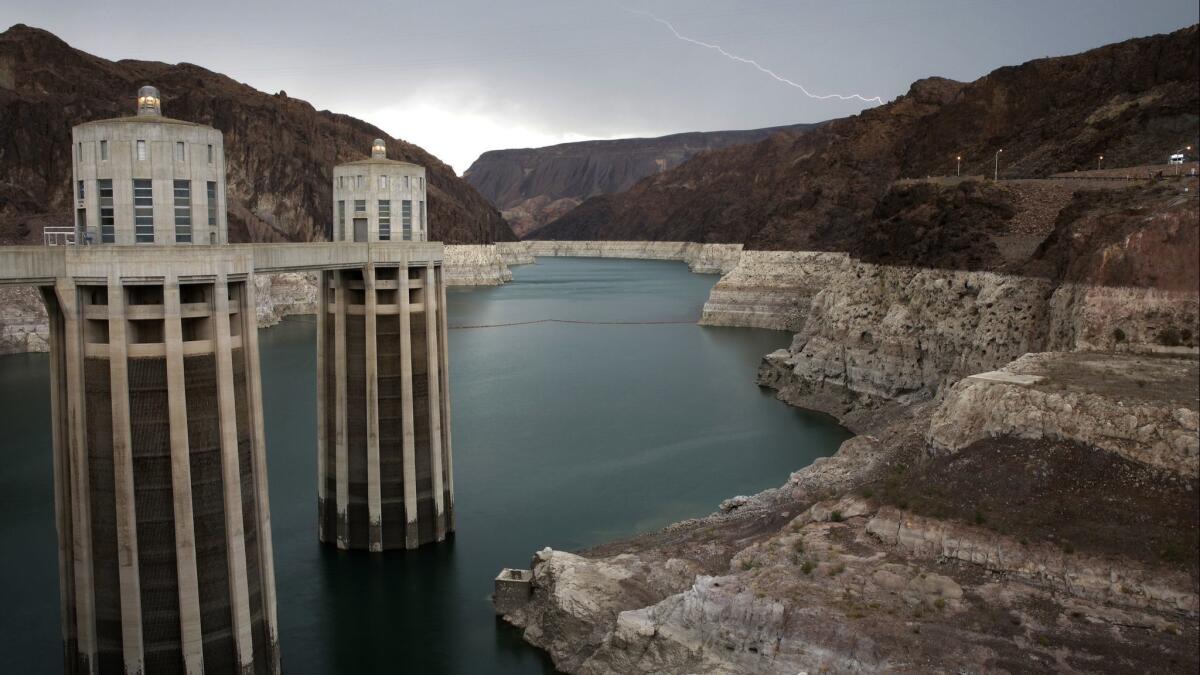As states near deal on Colorado River shortage, California looks at water cuts of as much as 8%

- Share via
After years of stop-and-go talks, California and two other states that take water from the lower Colorado River are nearing an agreement on how to share delivery cuts if a formal shortage is declared on the drought-plagued waterway.
Under the proposed pact, California — the river’s largest user — would reduce diversions earlier in a shortage than it would if the lower-basin states strictly adhered to a water-rights pecking order. California’s huge river take would drop 4.5% to 8% as the shortage progressed.
With occasional years of relief, the river that greens farm fields and fills faucets from Colorado to California has been stuck in drought since 2000. A shortage declaration has been looming over the seven-state basin for more than a decade, only to be narrowly averted time and again when rain and snow in the upper basin pushed reservoir levels above the trigger point.
But flows into Lake Powell — one of the Colorado’s two massive reservoirs — fell to a little more than a third of the average for the April-through-July period this year. And September’s inflow was negligible, less than 1% of the average. Looking at those numbers, federal officials say the U.S. Interior Department could declare a shortage in 2020.
“It’s pretty clear we’re in a deepening long-term drought cycle,” said Jeffrey Kightlinger, general manager of the Metropolitan Water District of Southern California, which has been importing Colorado River water to the region since the early 1940s. “It’s in everybody’s interest to prevent the system from cratering.”
The basin’s entire storage system is 47% full. Lake Powell, which stores runoff from the upper basin and releases it to Lake Mead, is 45% full. Mead, the source of Southern California’s river water, is 38% full.
The Interior secretary has never declared a shortage on the Colorado. But it has been known for years that the river is over-allocated. The basin states divvied up the flows in the early 20th century — a period that in hindsight was unusually wet and presented an unrealistic picture of what the Colorado could produce year in and year out.
Diversions are regulated by a complicated system of river compacts and water rights that call for Arizona and Nevada to take the first cuts in times of a lower-basin shortage. California, with some of the oldest river rights, is further down the line.
The sprawling Imperial Irrigation District and other farm districts in southeastern California control roughly 75% of California’s 4.4 million-acre-foot share. Imperial is the single largest user on the entire length of the river, which starts at the Continental Divide in the Colorado Rockies and has an average annual flow of roughly 15 million acre-feet.
Metropolitan has nearly doubled its base allocation of 550,000 acre-feet through agreements with Imperial and other irrigation districts that fallow crop land and sell their unused river supplies. Those deals would help cushion Metropolitan, which serves Southern California, if a shortage is declared. (An acre-foot is enough to supply more than two households for a year.)
Metropolitan would also benefit from water it has been able to bank in Lake Mead under 2007 drought guidelines that have allowed states to leave unused portions of their river allocations in the reservoir. Under the previous use-it-or-lose-it rules, states had to take their full allocation every year.
The 2007 framework specified that the Department of the Interior would declare a shortage when Lake Mead’s elevation hit 1,075 feet. Nevada and Arizona, which have rights junior to California, would then start delivery reductions.
Under the proposed drought contingency plan, Arizona and Nevada would continue to take the first cuts, which would be deeper than outlined in 2007. At the same time, California would reduce its river diversions when Mead levels hit 1,045 feet — earlier in the shortage than previously envisioned.
California’s cuts, shared by Imperial and Metropolitan, would increase as the lake level dropped but be no greater than 350,000 acre-feet a year.
Arizona is still working out the details of how to apportion its cuts among in-state users. And the lower-basin water districts have yet to approve the drought plan, which parties are hoping to finalize by December.
“I’ve got my own people asking tough questions. But I believe we can do it,” Metropolitan’s Kightlinger said.
A drought plan will not end debate among lower-basin users, who are confronting the fact that their use is outstripping the long-term supply.
“It’s not sustainable,” Kightlinger said. “We have to push it down or grow supply” with other sources.
Twitter: @boxall
More to Read
Sign up for Essential California
The most important California stories and recommendations in your inbox every morning.
You may occasionally receive promotional content from the Los Angeles Times.











